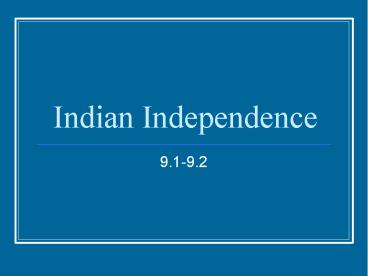Indian Independence - PowerPoint PPT Presentation
Title:
Indian Independence
Description:
... government President is head of state- has little power Two houses of Parliament The Rajya Sabha- Council of State The Lok Sabha- House of the People India ... – PowerPoint PPT presentation
Number of Views:136
Avg rating:3.0/5.0
Title: Indian Independence
1
Indian Independence
- 9.1-9.2
2
Growing Unrest
- In 1919, new laws from Britain
- Limited freedom of the press and other rights
- Protested by nationalists
- Five British officials killed in protests
- British General Reginald Dyer banned all public
gatherings to combat protests
NO PUBLIC GATHERSINGS!-
3
Amritsar Massacre
- April 13, 1919
- 10,000 Nationalists gather to defy orders of
Dyers orders- Amritsar - General Dyer- FIRE
- Some shot, others trampled
- 379 killed, more than 1,100 wounded
4
Amritsar Massacre
- Massacre deepened distrust between British and
Indians - Led to increased violence
- Made more Indians call for complete separation
5
Moving Toward Independence
- WWII broke out in 1939, and Britain became
involved - Indians had no desire to assist Britain in this
war - Indian National Council refused to support war
unless they were granted immediate independence - Britain refused such commands
6
Moving Towards Independence
- This refusal caused the Quit India movement
- Supported by Gandhi and other members of the INC
- Urged Indians to follow a policy of
non-cooperation and civil disobedience with
British - More than 20,000 members arrested
- By 1945- Britain could not keep India after the
war
7
Conflict between whom?
- What two groups have had the most conflict in
Indian history? - Who wanted a separate country?
8
The Subcontinent Divided
- 1946- rioting spread between Hindus and Muslims
- 1947- Britain passes the Indian Independence Act
- Ended British rule in India
- Subcontinent divided into two separate countries
- India and Pakistan
9
(No Transcript)
10
The Subcontinent Divided
- This partition led to an explosion of violence
- Why riot?
- What happens to Muslims and Hindus in each
country? - Gandhi refused to celebrate Indias independence
on August 15, 1947 - One year later, he was assassinated
11
Indias Government
- Indias constitution created a federal system
- They became a Parliamentary Democracy
- Based on British form of government
- President is head of state- has little power
- Two houses of Parliament
- The Rajya Sabha- Council of State
- The Lok Sabha- House of the People
12
Indias Government
- India has more than 12 national political parties
- Parties represent the interests of different
caste, language, religious or regional groups - The Bharata Janata Party dominates Parliament now
13
Dividing and Unifying Forces
- The population of India has more than doubled
since independence - Poverty and illiteracy are still widespread
despite government attempts to change that - The caste system is still a dividing force
- Untouchability made illegal
- Effects still felt
14
Dividing and Unifying Forces
- Cultural Diversity
- Language and ethnic groups want their own
countries - Sikh Separatism
- Religious minority in India
- Blends Islam and Hinduism
- One God and rejects caste system
- 1984- Sikh extremists occupy Golden Temple,
refuse to leave - Government ordered attack- many Sikhs killed
15
More Hindu- Muslim Clashes
- Many Muslims had fled to Pakistan
- Some did remain
- Clash over mosque in Ayodhya
- Hindus claim birthplace of the god Rama
- 1992- Hindus attack mosque
- Hundreds killed from both religions
- 2002- Plan to build Hindu temple sparked bloody
rebellion and more than 600 Indians killed
16
Unifying Forces
- Despite all of the bad, there is a commitment to
Democratic traditions - Also, common faith of many Indians- Hinduism
- Modern communications and strong leaders also
unifies India
17
Indias Leaders
- Jawaharlal Nehru led India for 17 years after
independence - Wanted to make India modern industrial nation
- Hoped to create a casteless, secular India
- No official religion
- Set up programs for schools and economic
development
18
Indias Leaders
- Indira Gandhi
- Nehrus Daughter
- Elected Prime Minister in 1966
- 1975- tried to jail opponents and limit some
freedoms - Forced to return to democratic rule
- 1984- ordered troops to storm the Golden Temple
- Who was there?
- 1984- assassinated by two of her Sikh bodyguards
because of her actions at the Golden Temple - Rajiv Gandhi elected Prime Minister after his
mothers death - Murdered by a group of Tamil Tigers in nearby Sri
Lanka































